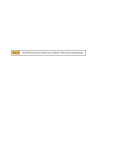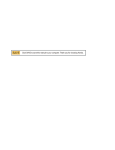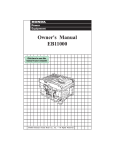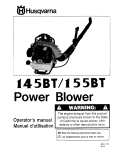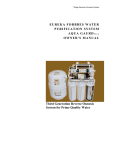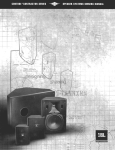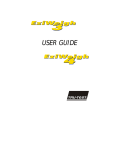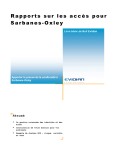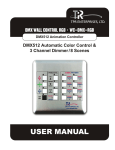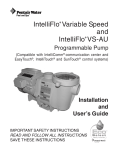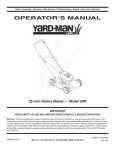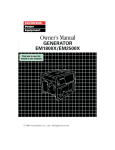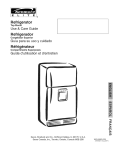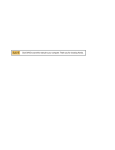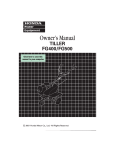Download Honda WP20X WP30X User's Manual
Transcript
The engine exhaustfrom this product contains chemicals known to the State of California to cause cancer, birth Keep this owner's manualhandy, so you can refer toit a t any time. Thisowner'smanual is considered a permanentpartofthewater pump and should remain with the water pump if resold. The information and specifications included in this publication were in effect at thetimeofapprovalforprinting.HondaMotor Co., Ltd. reserves the right, however, to discontinue or change specifications or design a t any time without notice and without incurring any obligation whatever. No partofthispublicationmay be reproducedwithout written permission. INTRODUCTION A FEWWORDS ABOUT SAFETY Your safety and the safetyof others are very important. And using this water pump safely isan important responsibility. To help you make informed decisions about safety, we have provided operatingproceduresandotherinformationonlabelsandinthis manual. This information alerts you to potential hazards that could hurt you or others. Of course, it is not practical or possible to warn you about all the hazards associated with operating or maintaining a water pump. You must use your own good judgment. You willfindimportant including: safetyinformationin a varietyofforms, Safety Labels - on the pump. Safety Messages - preceded by a safety alert symbol L?L and one of three signal words, DANGER, WARNING, or CAUTION. These signal words mean: You WILL be KILLED or SERIOUSLY HURT if you don‘t follow instructions. YouCAN beKILLED or SERIOUSLY HURT if you don’t follow instructions. You CAN be instructions. HURT ifyoudon’tfollow Safety Headings - such as IMPORTANTSAFETYINFORMATION. Safety Section - such as PUMP SAFETY Instructions - how touse this pump correctly and safely. This entire book is filled with important safety information read it carefully. 2 - please I CONTENTS PUMP SAFETY ........................................................................................... IMPORTANT SAFETY INFORMATION ................................................. SAFETY LABEL LOCATIONS ................................................................. 5 5 7 CONTROLS & FEATURES ......................................................................... COMPONENT & CONTROL LOCATIONS ............................................. CONTROLS ........................................................................................... Fuel Valve Lever ............................................................................... Ignition Switch .................................................................................. Choke Lever ...................................................................................... Throttle Lever ................................................................................... Recoil Starter Grip ............................................................................ FEATURES ............................................................................................ Oil A l e e System .............................................................................. 8 8 10 10 10 11 11 12 12 12 BEFORE OPERATION .............................................................................. ARE YOU READY TO GET STARTED?................................................ IS YOUR PUMP READY TO GO? ......................................................... Check the General Condition of the Pump..................................... Check the Suction andDischarge Hoses........................................ Check the Engine .............................................................................. 13 13 14 14 15 15 OPERATION ............................................................................................. SAFE OPERATING PRECAUTIONS .................................................... PUMP PLACEMENT ............................................................................. SUCTION HOSE INSTALLATION ........................................................ DISCHARGE HOSE INSTALLATION ................................................... PRIMING THE PUMP ............................................................................ STARTING THE ENGINE ..................................................................... SETTING ENGINE SPEED .................................................................... STOPPING THE ENGINE ..................................................................... 16 16 17 18 19 19 20 22 23 SERVICING YOUR PUMP ........................................................................ THE IMPORTANCE OF MAINTENANCE ............................................. MAINTENANCE SAFETY ..................................................................... MAINTENANCE SCHEDULE ............................................................... REFUELING ........................................................................................... RECOMMENDATIONS FUEL .............................................................. ENGINE OIL LEVEL CHECK ................................................................. ENGINE OIL CHANGE.......................................................................... 25 25 26 27 28 29 30 31 3 CONTENTS SERVICING YOUR PUMP (continued) ENGINE OIL RECOMMENDATIONS ................................................... AIR FILTER INSPECTION ..................................................................... AIR FILTER CLEANING ........................................................................ SEDIMENT CUP CLEANING ................................................................ SPARK PLUG SERVICE ........................................................................ IDLE SPEED ADJUSTMENT ................................................................ SPARK ARRESTER SERVICE (optional equipment).......................... 32 33 34 35 36 38 39 STORAGE ................................................................................................. STORAGE PREPARATION ................................................................... Cleaning ............................................................................................ Fuel .................................................................................................... Engine Oil .......................................................................................... STORAGE PRECAUTIONS .................................................................. REMOVAL FROM STORAGE ............................................................... 40 40 40 41 44 44 45 TRANSPORTING ...................................................................................... 46 TAKING CARE OF UNEXPECTED PROBLEMS...................................... ENGINE ................................................................................................. Engine Will Not Start....................................................................... Engine Lacks Power ......................................................................... PUMP .................................................................................................... No Pump Output .............................................................................. Low Pump Output............................................................................ 47 47 47 47 48 48 48 TECHNICAL & CONSUMER INFORMATION ......................................... 49 TECHNICAL INFORMATION ................................................................ 49 Serial Number Location................................................................... 49 Carburetor Modification for High Altitude Operation...................50 Oxygenated Fuels ............................................................................ 51 Emission Control System Information ........................................... 52 Air Index ............................................................................................ 54 Specifications ................................................................................... 55 CONSUMER INFORMATION ............................................................... 59 Honda Publications .......................................................................... 59 Customer Service Information ........................................................ 60 QUICK REFERENCE INFORMATION 4 ............................ Inside back cover IMPORTANT SAFETY INFORMATION Honda WP2OX and WP3OX pumps are designed to pump only water that is not intended for human consumption, and other uses can result in injury to the operator or damage to the pump and other property Most accidents can be prevented if you follow all instructions in this manual and on the pump. The most common hazards are discussed below, along with the best way to protect yourself and others. Operator Responsibility It is the operator’s responsibility to provide the necessary safeguards to protect people and property. Know how to stop the pump quickly in case of emergency. If youleave the pump for anyreason, always turn the engine off. Understand theuse of all controls and connections. Be sure that anyonewhooperatesthepump instruction. Do not let children operate the pump. pets away from the area of operation. receives proper Keep children and Pump Operation Pumponlywaterthatisnotintendedforhumanconsumption. Pumping flammable liquids, suchas gasoline or fuel oils, can result in afireorexplosion,causingseriousinjury.Pumping sea water, beverages, acids, chemical solutions, or any other liquid that promotes corrosion can damage the pump. Refuel With Care Gasoline is extremely flammable, and gasoline vapor can explode. Refuel outdoors, in a well-ventilated area, with the engine stopped and the pump on a level surface. Do not fill the fuel tank above the fuel strainer shoulder. Never smoke near gasoline, and keep other flames and sparksaway. Always store gasoline in an approved container. Make sure that any spilled fuelhas been wiped up before starting the engine. 5 PUMP SAFETY Hot Exhaust The muffler becomes very hot during operation and remains hot for a while after stopping the engine. Be careful not to touch the muffler while it is hot. Let the engine cool before transporting the pump or storing it indoors. To prevent fire hazards, keep the pump a t least 3 feet ( 1 meter) away from building walls and other equipment during operation. Do not place flammable objects close to the engine. Carbon Monoxide Hazard Exhaust gas contains poisonous carbon monoxide. Avoid inhalation of exhaust gas. Never run the engine in a closed garage or confinedarea. PUMP SAFETY SAFETY LABEL LOCATION The label shown here contains important safety information. Please read it carefully. This label is considered a permanent part of your pump. If the label comes off or becomeshard to read, contactan authorized Honda servicing dealer for a replacement. 7WARNINGDO NOT PUMP FLAMMABLE OR CORROSIVEMATERIALS. AN EXPLOSION OR FIRE COULD RESULT, CAUSING , SEVERE PERSONAL INJURY. 7 CONTROLS & FEATURES COMPONENT & CONTROL LOCATIONS <WPPOX > FUEL FILLER CAP DISCHARGE PORT THROlTLE LEVER CHOKE LEVER FUEL VALVE LEVER - OIL FILLER CAP/DIPSTICK IGNITION SWITCH FRAME PRIMING W FILLER CAP SUCTION PORT STRAINER PUMP DRAIN PLUG 8 CONTROLS & FEATURES <WP3OX > FUEL FILLER CAP DISCHARGE PORT THROlTLE LEVER \ CHOKE LEVER FUEL VALVE LEVER ” - OIL FILLER CAP/DIPSTICK 7, IGNITION SWITCH MUFFLER \ 9 CONTROLS & FEATURES CONTROLS Fuel Valve Lever The fuel valve opens and closes the connection between the fuel tank and the carburetor. FUEL VALVE LEVER I '-i The fuel valve lever must be in the ON position for the engine to run. Whentheengineisnot in use, leave the fuel valve lever in the O F F p o s i t i o nt op r e v e n t carburetor flooding and to reduce the possibility of fuel leakage. OFF .' Ignition Switch IGNITION SWITCH Theignitionswitchcontrolsthe ignition system. The ignition switch must bein the ON position for the engine to run. Turning the ignition switch to the OFF position stops the engine. 10 .---- CONTROLS & FEATURES Choke Lever CHOKE LEVER The choke lever opens and closes the choke valvein the carburetor. t enriches The CLOSED position the fuel mixture for startinga cold engine. The OPEN positionprovidesthe correct fuel mixture for operation after starting, and for restarting a warm engine. CL Throttle Lever The throttle lever controls engine speed. Movingthethrottleleverinthe directionsshownmakesthe engine run faster or slower. by Pump output is controlled adjustingthethrottle lever. At maximumthrottleposition,the pumpwilldeliverthehighest o u t p uvt o l u m eM . o v i n gt h e throttle lever toward the idle position will decrease the output volume of the pump. 11 CONTROLS & FEATURES Recoil Starter Grip Pulling the starter grip operates the recoil starterto crank the engine. STARTER GRIP FEATURES Oil Alert@ System The Oil Ale@ system is designed t o prevent engine damage caused by an insufficient amount of oil in the crankcase. Before the oil level in the crankcase can fall below a safe limit, the Oil Ale@ system will automatically stop the engine (the ignition switch will remain in the ON position). If the engine stops and will not restart, check the engine oil level (page 30 ) before troubleshooting in other areas. 12 ARE YOU READY TO GET STARTED? Your safety is your responsibility. A little time spent in preparation will significantly reduce your risk of injury. Knowledge Read and understand this manual. Know what the controls do and how tooperate them. Familiarize yourself with the pump andits operation before you begin pumping. Know what todo in case of emergencies. Be sure of what you are pumping. This pump is designed to pump only water thatis not intended for human consumption. 13 IS YOUR PUMP READY TO GO? For your safety, and to maximize the service life of your equipment,it is very important totake a few moments before you operate the pump to check its condition. Be sure to take care of any problem you find, or have your servicing dealer correct it, before you operate the pump. Improperly maintaining this pump, or failing to correct a problem before operation, couldcause a malfunction in which you could be seriously injured. Always perform a preoperation inspection beforeeach operation, and correct any problem. Exhaust gas contains poisonous carbon monoxide. Avoid inhalation of exhaust gas. Never run the engine in a closed garage or confinedarea. To prevent fire hazards, keep the pump a t least 3 feet (1 meter) away from building walls and other equipment during operation. Do not place flammable objects close to the engine. Before beginning your preoperation checks, be sure the pump is on a level surface and the ignition switch is in theOFF position. Check the General Conditionof the Pump Look around and underneath the pump for signs of oil or gasoline leaks. Remove any excessive dirt or debris, especially around the engine muffler, and recoil starter. Look for signs of damage. Check that all nuts, bolts, screws, hose connectors and clamps are tightened. 14 BEFORE OPERATION Check the Suction and Discharge Hoses Check the general condition of the hoses. Be sure the hoses are in serviceable condition before connecting them to the pump. Remember that the suction hose must be reinforced construction to prevent hosecollapse. Check that the sealing washer in the suction hose connector is in good condition(see page18 1. Check that the hose connectors and clamps (see pages 18 & 19 ). are securely installed Check that the strainer is in good condition and is installed on the suction hose (see page 18 1. Check the Engine Check the oil level (see page 30). To avoid the inconvenience of an unexpected shutdown by the Oil Alert@ system, always check the engine oil level before startup. Check the air filter(see page33 ), A dirty air filterwill restrict air flow to thecarburetor, reducing engine andpump performance. Check the fuel level (see page 28). Starting with a full tank will help to eliminate or reduce operating interruptions for refueling. 15 SAFE OPERATING PRECAUTIONS To safely realize the full potential of this pump, you need a complete understanding of its operation and a certain amount of practice with its controls. Before operatingthepumpforthefirsttime, please reviewthe IMPORTANT SAFEN INFORMATION on page 5 and the chapter titled BEFORE OPERA TION. For your safety, avoid starting or operating the engine in an enclosed area, such as agarage. Your engine’s exhaust contains poisonous carbon monoxide gas which can collect rapidly i n an enclosed area and cause illness ordeath. Pumponlywaterthatisnotintendedforhumanconsumption. Pumping flammable liquids, suchas gasoline or fueloils, can result in afireorexplosion,causingseriousinjury.Pumping sea water, beverages, acids, chemical solutions, or any other liquid that promotes corrosion can damage the pump. 16 OPERATION PUMP PLACEMENT For best pump performance, place the pump near the water level, and usehosesthat are no longer than necessary. That will enablethe pump to produce the greatest output with the least self-priming time. As head (pumping height) increases, pumpoutput decreases. Maximum headspecificationsand pumpperformancecurves are shown in the tables on pages56 and 58. The length, type, and size of the suction and discharge hoses can also significantly affect pump output. Discharge head capability is always greater than suction head capability, so it is important for suction head to be the shorter part of total head. is Minimizing suction head (placing the pump near the water level) also very important for reducing self-priming time. Self-priming time is the timeit takes the pump to bring water the distance of the suction head during initial operation. 17 OPERATION SUCTION HOSE INSTALLATION Use the commercially available hose and hose connector with the hoseclampprovided with thepump.Thesuction-hosemustbe reinforced with a noncollapsible wall or braided wire construction. The suction hose should be no longer than necessary. Pump performance is best when the pump is near the water level, and the hoses are short. Use a hose clampto securely fasten the hose connectorto the suction hose in order to prevent air leakage and loss of suction. Verify that the hose connector sealing washer is in good condition. Install the strainer (provided with the pump) on the other end of the suction hose, and secure it with a hose clamp. The strainerwill help to or damaged by debris. prevent the pump from becoming clogged pump suction port. Securely tighten the hose connector on the SUCTION PORT HOSE CLAMP RING SUCTION HOSE HOSE CONNEC 18 OPERATION DISCHARGE HOSEINSTALLATION Use a commercially available hoseandhoseconnector, and clamp providedwith the pump. DISCHARGE HOSE It is best to use a short, large-diameter hose, because that will reduce fluid friction and improve pumpoutput. A longorsmalldiameter hose will increase fluid friction and reduce pump output. Tighten hose clamp securely the to prevent the discharge hose from disconnecting under high pressure. I HOSE CLAMP PRIMING THE PUMP Beforestartingthe engine, removethefillercapfrom the pump chamber, and completely fill the pump chamber with water. Reinstall the fillercap, and tightenit securely.' m Operating the pump dry willdestroy the pump seal. If the pump has been operated dry, stop the engine immediately, and allow the pump to cool before priming. PRIMING WATER FILLER CAP '\.\..j 1 19 OPERATION STARTING THE ENGINE 1. Prime the pump(see page19 ). 2. Move the fuel valve lever to ON the position. ' FUEL VALVE LEVER 3. To start a cold engine, move thechoke lever to the CLOSED position. To restart awarm engine, leave the choke leverin the OPEN position. CL 4. Move the throttle lever away from theSLOW position, about 1/3 of the way toward the FAST position. THROT~LELEVER 20 OPERATION 5. Turn the ignition switch to the ON position. IGNITION SWITCH 6. Pull the starter grip lightly until resistance is felt, then pull it briskly. Do not allow the starter grip to snap back against the engine. Return it gently to prevent damage to the starter. STARTER GRIP 21 OPERATION 7. If the choke lever was moved to the CLOSED position to start the engine, gradually moveit to theOPEN position as the engine warms UP- ; \\ --CHOKE LEVER SETTING ENGINESPEED After starting the engine, move the throttle lever to theFAST position for self-priming, andcheck pump output. Pumpoutputiscontrolled by adjustingengine speed. Moving the throttle lever in the FAST direction will increase pump output, and moving the throttle lever in the SLOW direction will decrease pump output. 22 OPERATION STOPPING THE ENGINE To stop the engine inan emergency, simply turn the ignition switch to the OFF position. Under normal conditions, use the following procedure. 1. Move the throttle lever to SLOW the position. 2. Turn the ignition switch to the OFF position. IGNITION SWITCH 23 OPERATION 3. Turn the fuel valve lever to OFF the position. After use, remove the pump drain plug (see page41 1, and drain the pump chamber. Remove the filler cap, and flush the pump chamber with clean, freshwater.Allowthewatertodrainfromthepump chamber, then reinstall the fillercap and drain plug. 24 . ' SERVICING YOUR PUMP THE IMPORTANCE OF MAINTENANCE Good maintenance is essential for safe, economical, and trouble-free operation. It will also help reduce air pollution. Improperly maintaining this pump, or failure to correct a problem before operation, can cause a malfunction in which you can be seriously hurt orkilled. Always follow the inspection and maintenance recommendations and schedules in this owner's manual. To help you properlycare for your pump, the following pages include a maintenance schedule, routine inspection procedures, and simple maintenance procedures using basic hand tools. Other service tasks that are more difficult, or require special tools, are best handled by professionals and are normally performed by a Honda technician or other qualified mechanic. The maintenance schedule applies to normal operating conditions. If you operate your pump under severe conditions, such as sustained high-load or high-temperature operation, or use in unusually wet or dusty conditions, consult your servicing dealer for recommendations applicable to your individualneeds and use. Rememberthatyourservicing dealer knowsyourpumpbestandis it. fully equipped to maintain and repair To ensurethebestqualityandreliability,useonly new, genuine Honda partsor their equivalents for repair and replacement. Maintenance, replacement, or repair of emission control devices and systems may be performed by any engine repair establishment or individual, using parts that are "certified" to EPA standards. 25 SERVICING YOUR PUMP MAINTENANCE SAFETY Some of the most important safety precautions follow. However, we cannotwarnyouofeveryconceivable hazard thatcan arise in performing maintenance. Only you can decide whether or not you should performa given task. Failure to properly follow maintenance instructions and precautions cancause you tobe seriously hurt orkilled. Always follow the procedures and precautions in the owner’s manual. Safety Precautions Make sure the engine is off before you begin any maintenance or repairs. Thiswill eliminate several potential hazards: -Carbon monoxide poisoning from engine exhaust. Be sure there is adequate ventilation whenever you operate the engine. -Burns from hot parts. Let the engine and exhaust system cool before touching. -Injury from moving parts. Do not run the engine unless instructed toso. do Read the instructions before youbegin, and make sure you have the tools and skills required. Toreduce thepossibilityoffireorexplosion,becarefulwhen workingaroundgasoline.Useonly a nonflammablesolvent,not gasoline, to clean parts. Keep cigarettes, sparks, and flames away from all fuel-relatedparts. 26 SERVICING YOUR PUMP MAINTENANCE SCHEDULE Every 3 months or 50 Hrs. Every 6 months or 100 Hrs. Every year or 300 Hrs. n 0(1) n 0 0 0 !revery 5 1 Hrs (2) chamber Check Every tube Fuel Impeller Impeller clearance Pump inlet valve 2 years (Replace if necessary) (2) Check Check Check 0 (2) 0 (2) 0 (2) Emission-related items. (1) Service more frequently whenused in dusty areas. (2) These itemsshouldbeservicedbyyourservicing dealer, unless you have the proper tools and are mechanically proficient. Refer t o Honda shop manual forservice procedures. (3) For commercial use, log hours of operationtodetermineproper maintenance intervals. 27 SERVICING YOUR PUMP REFUELING Fuel tank capacities WP2OX: 0.66 US gal (2.5 !J,0.55 Imp gal) WP3OX: 0.95 US gal (3.6 0 ,0.79 Imp gal) With the engine stopped, remove the fuel tank cap andcheck the fuel level. Refill the tank if the fuel level is low. Gasoline is highly flammable and explosive. You can be burned or seriously injured when handling fuel. Stop the engine and keep heat, sparks, and flame away. Handle fuel only outdoors. Wipe up spills immediately. MAXIMUM FUEL LEVEL - 28 - - SERVICING YOUR PUMP Refuel in a well-ventilated area before starting the engine. If the engine has been running, allowit to cool. Refuelcarefully to avoid spillingfuel. Do not fill the fuel tank above the fuel strainer shoulder. After refue tighten the fuel tank cap securely. Never refuel the engine inside a building where gasoline fumes may reach flames orsparks. Keep gasoline awayfrom appliance pilotlights, barbecues, electric appliances, power tools,etc. Spilled fuel is not only a firehazard, it causes environmental damage. Wipe up spills immediately. Fuel can damage paint and plastic. Be careful not to spill fuel when filling your fuel tank. Damage caused by spilled fuel is not covered under warranty. FUEL RECOMMENDATIONS Use unleaded gasoline with a pump octane rating of 86 or higher. These engines are certifiedto operate on unleaded gasoline. Unleaded gasoline produces fewer engine and spark plug deposits and extends exhaust system life. Never use stale or contaminated gasoline or an oil/gasoline mixture. Avoid getting dirt or water in the tank. fuel Occasionally youmay hearalight"spark knock" or"pinging" (metallic rapping noise) while operating under heavy loads. This is no cause for concern. Ifsparkknock or pinging occurs a t asteadyengine speed, under normal load, change brands of gasoline. If spark knock or pinging persists, see an authorized Honda servicing dealer. 1Running the engine with persistent spark knock or pinging can cause engine damage. Running the engine with persistent spark knock or pinging is misuse, and the Distributor's Limited Warrantydoes not cover parts damaged by misuse. 29 SERVICING YOUR PUMP ~ ~ ENGINE OIL LEVEL CHECK Check theengineoillevelwiththeenginestoppedandinalevel position. 1. Remove the oil filler cap/dipstick and wipe it clean. 2. Insert and remove the dipstick without screwing it into the fillerneck. Check the oil level shown on the dipstick. 3. If the oil level is low, fill to the edge recommended oil(see page 32). of the oil filler hole with the 4. Screw in the oil filler cap/dipstick securely. FILLER CAP/DIPSTICK LOWER LIMIT The Oil Alert@ system will automatically stop the engine before the oil level falls below safe limits. However, to avoid the inconvenience of an unexpected shutdown, check the oil level regularly. 30 SERVICING YOUR PUMP ENGINE OIL CHANGE Drain the used oil while the engine is warm. Warm oil drains quickly and completely. 1. Place a suitable container below the engine to catch the used oil, then remove the oil filler cap/dipstick and the drain plug. 2.Allow the used oil to drain completely, then reinstall the drain plug, and tightenit securely. Please dispose of used motor oil in a manner that is compatible with the environment. We suggest you take used oil in a sealed container to your local recycling center or service station for reclamation. Do not throwit in the trash ,pour it on the ground, or down a drain. 3. With the engine in a level position, fill to the outer edge of the oil filler hole with the recommended (see oil page 32 ). Engine oil capacity: 0.63 US qt (0.60 0, 0.53 Imp qt) The Oil Ale@ system will automatically stop the engine before the the oil level falls below the safe limit. However, to avoid inconvenience of an unexpected shutdown, fill to the upper limit, and check the oil level regularly. 4. Screw in the oil filler cap/dipsticksecurely. OIL LEVEL DRAIN PLUG OIL FILLER CAP/DIPSTICK 31 I 1 SERVICING YOUR PUMP ENGINE OIL RECOMMENDATIONS Oil is a major factor affecting performance and service life. Use 4-stroke automotive detergent oil. SAE IOW-30 is recommended for generaluse. Other viscosities shown in the chart may be used when the average temperature in your area is within the recommended range. SAE Viscosity Grades SAE 1 1 1 1 1OW-30 I 5w-30 TEMP -20 -30 I I A 0 I -20 -10 8OI lw, OF 1O 20 30 40°C 20 , 40 , 60 0 I AMBIENT TEMPERATURE The SAE oil viscosity and service classification are in the API label o n theoilcontainer.Hondarecommends that you use API SERVICE category SJ oil. The recommended operating range of this pump 23 is O F to 104 OF (-5 "C to 40 "C). 32 SERVICING YOUR PUMP AIR FILTER INSPECTION Unscrew the wing nut and remove the cleaner air cover. Check the air filter to be sureit is clean and in good condition. it as described on page 34. Replace the air If the air filter is dirty, clean filter ifit is damaged. Reinstall the air filter and air cleaner cover. Be sure all the parts shown below are in place. Tighten the wing nut securely. pEE-1 Operating the engine without an air filter, or witha damaged air filter, will allow dirt toenter the engine, causingrapid enginewear. Thistype of damage isnot covered by the Distributor's Limited Warranty. NUT AIR CLEANER COVER COVER WASHER FILTER GRID 33 SERVICING YOUR PUMP AIR FILTER CLEANING A dirty air filter will restrict air flow to the carburetor, reducing engine performance. If you operate the pump in very dusty areas, clean the airfiltermorefrequentlythanspecifiedinthe MAINTENANCE SCHEDULE (see page27 1. 1. Clean the air filter in warm soapy water, rinse, and allow to dry thoroughly. Or clean in nonflammable solvent and allow to dry. 2. Dip the air filter in clean engine oil, then squeeze out all excess oil. The engine will smoke when started if too much oil is left in the foam. 3. Wipe dirt from the air cleanerbase and cover, using a moist rag. Be careful to prevent dirt from entering the air duct that leads to the carburetor. 34 SERVICING YOUR PUMP SEDIMENT CUP CLEANING 1. Move the fuel valve lever to theOFF position, then remove the fuel sediment cup and O-ring. Gasoline is highly flammable and explosive. You can be burned or seriously injured when handling fuel. Stop the engine andkeep heat, sparks, and flame away. Handle fuel only outdoors. Wipe up spills immediately. 2. Wash the sediment cup and O-ring in nonflammable solvent, and dry them thoroughly. 3. Place the O-ring in the fuel valve,and Tighten the sediment cup securely. install the sediment cup. 4. Move the fuel valve lever to the ON position, and check for leaks. Replace the O-ring if there is any leakage. 35 SERVICING YOUR PUMP SPARK PLUG SERVICE In order to service the spark plug, youwill need a spark plug wrench (commercially available). Recommended spark plug: BPR6ES (NGK) W20EPR-U (DENSO) p q i Incorrect spark plugs can causeengine damage. 1. Disconnect the spark plug cap, and remove anydirt from around the spark plug area. 2. Remove the spark plug with13/16-inch a spark plug wrench 3. Inspect the spark plug. Replace it if the electrodes are worn, or iftheinsulatoris cracked or chipped. Clean thesparkplug with a wirebrush if you are going toreuse it. 4 . M e a s u r et h es p a r kp l u g electrodegapwithasuitable gauge. Correct thegap, if necessary, by carefully bending the side electrode. The gap should be: 0.028-0.031 in (0.70-0.80 mm) 36 0.028-0.031 in (0.70-0.80 rnrn) SERVICING YOUR PUMP 5. Install thespark plug carefully, by hand, to avoid cross-threading. 6.Afterthe spark plug seats, tightenwitha wrench to compress the washer. 13/16-inchspark plug If reinstalling the used spark plug, tighten 1/8-1/4 turn after the spark plug seats. If installing a new spark plug, tighten 1/2 turn after the spark plug seats. pi6K-l A loose spark plug can overheatand damage the engine. Overtightening the spark plug can damage the threads in the cylinder head. 7. Attach the spark plug cap. 37 SERVICING YOUR PUMP IDLE SPEEDADJUSTMENT 1.Stat-t the engine outdoors, and allow temperature. it to warm up to operating 1Dry operation will damage the pump seal. Be surethe chamber is filled withwater before starting theengine. 2. Move the throttle lever to its slowest position. 3. Turn the throttle stop screw to obtain the standardspeed. idle Standard idle speed: 1,400 ?% rpm '\ THROTTLE STOPSCREW 38 pump SERVICING YOUR PUMP SPARK ARRESTER SERVICE(optional equipment) Your engine is not factory-equipped with a spark arrester. In some areas, it is illegal to operate an engine without aspark arrester. Check local laws and regulations. A spark arrester is available from authorized Honda servicing dealers. Thesparkarrester mustbeservicedevery functioning as designed. 100 hoursto keep it If the engine has been running, the muffler will be very hot. Allow the muffler to cool before servicing the spark arrester. 1. Remove the two8 m m nuts, and remove the muffler. 2. Remove the four5 m m self-tapping screws, and remove the muffler protector from the muffler. 3. Remove the 4 m m screw from the spark arrester, and remove the spark arresterfrom the muffler. 5 mm SELF-TAPPING MUFFLER PROTECTOR 4 mm SCREW SPARK ARRESTER 4. Use a brush to remove carbon deposits from the spark arrester screen. Be careful to avoid damaging thescreen. The spark arrester must be free of breaks andholes. Replace the spark arrester if it i s damaged. SCREEN 5. Install the spark arrester and muffler protector in the reverse order of disassembly. 39 STORAGE STORAGE PREPARATION Properstoragepreparationisessentialforkeepingyourpump troublefree and looking good. The following steps will help to keep rust and corrosion from impairing your pump’s function and appearance, and will make the engine easierto start when youuse the pump again. Cleaning 1. Wash the engine and pump. Wash the engine by hand, and be careful to prevent water from entering the air cleaner or muffler opening. Keep water away from controlsand all other places that are difficulttodry, as water promotes rust. - 1- Using a garden hose or pressure washing equipment can force water into the air cleaner or muffler opening. Water in the air cleaner will soak the air filter, and water that passes through the air filteror muffler can enterthe cylinder, causing damage. Water contacting a hot engine can cause damage. If the engine has been running, allow it to cool for at least half an hour before washing. 2. Wipe dry all accessible surfaces. 3. Fill the pump chamber with clean, freshwater, start the engine outdoors, and let it run until it reaches normal operating temperature to evaporate any external water. p7EE-l Dry operation will damage the pump seal. Be sure the pump chamber is filled withwater before starting the engine. 40 STORAGE 4. Stop the engine, and allow it to cool. 5. Remove the pump drain plug, and flush the pump with clean, fresh water. Allow the water to drain from the pump chamber, then reinstall the drain plug. 6. After the pump is clean and dry, touchupanydamagedpaint, andcoat areas thatmayrust with a light film of oil. Lubricate controlswith a siliconespray lubricant. Fuel Gasoline will oxidizeanddeteriorate in storage.Oldgasoline will cause hardstarting,and it leaves gum deposits that clog the fuel system. If the gasoline in your engine deteriorates duringstorage, you may need to. have the carburetor and other fuel system components serviced or replaced. The length of time that gasoline can be left in your fuel tank and carburetor without causing functional problems will vary with such factors as gasoline blend, your storage temperatures, and whether the fuel tank is partially or completely filled. Theinair a partially filled fuel tankpromotesfueldeterioration. Very warmstorage/temperatures accelerate fuel deterioration. Fuel deterioration problems may occur within a few months, or even less if the gasoline was not fresh when you filled the fuel tank. The Distributor’s Limited Warranty doesnotcoverfuelsystem damage or engine performance problems resulting from neglected storage preparation. Youcanextendfuelstoragelife by adding a fuel stabilizer that formulatedforthatpurpose,oryoucanavoidfueldeterioration problems by draining the fuel tank and carburetor. is 41 STORAGE Adding a Fuel Stabilizer to Extend FuelStorage Life When adding a fuel stabilizer, fill the fuel tank with fresh gasoline. If onlypartiallyfilled,airinthe tank willpromotefueldeterioration during storage. If you keep a container of gasoline for refueling, be sure that it contains only fresh gasoline. 1. Add fuel stabilizer following the manufacturer's instructions. 2.After adding a fuel stabilizer, run the engine outdoors for 10 minutes to be sure that treated gasolinehas replaced the untreated gasoline in the carburetor. INOTICE I Dry operation will damage the pump seal. Be sure thepump chamber is filled withwater before starting the engine. 3. Stop theengine, and move the fuel valve lever to OFF the position. FUEL VALVE LEVER \ OFF 42 STORAGE Draining the Fuel Tank and Carburetor 1. Place an approved gasoline container below the carburetor, and use a funnel to avoid spilling fuel. 2. Remove the carburetor drain bolt and sediment cup, then move the fuel valve lever to the ON position. Gasoline is highly flammable and explosive. You can be burned or seriously injured when handling fuel. Keep heat, sparks, and flame away. Handle fuel only outdoors. Wipe up spills immediately. DRAIN BOLT .SEDIMENT CUP 3.After all the fuel has drained into the container, reinstall the drain bolt and sediment cup. Tighten them securely. 43 STORAGE Engine Oil 1. Change the engine oil(see page31 ). 2. Remove the spark plug (see page36 1. 3. Pour a tablespoon(5-10 cc) of clean engine oil into the cylinder. 4. Pull the starter grip several times to distribute the oilin the cylinder. 5. Reinstall the spark plug. 6. Pull the starter grip slowly until resistance is felt and the notch on the starter pulley aligns with the hole at the top of the recoil starter cover. This will close the valvesso moisture cannot enter the engine cylinder. Return the starter grip gently. -Align notch on pulley with hole at top of cover. STORAGE PRECAUTIONS If yourpump will bestoredwithgasoline in thefueltankand carburetor, it is important to reducethe hazard of gasolinevapor ignition. Select awell-ventilated storage area away from any appliance that operates with a flame, such as a furnace, water heater, or clothes dryer. Also avoid any area with a spark-producing electric motor, or where power toolsare operated. If possible,avoidstorage areas withhighhumidity, promotes rust and corrosion. because that Unless all fuel has been drained from thetank, fuel leave the fuel valve lever in theOFF position to reduce the possibility of fuel leakage. 44 STORAGE Place the pump on a level surface. Tilting can cause fuel or oilleakage. With the engine and exhaust system cool, cover the pump tokeep out dust. A hotengineandexhaustsystemcanigniteormeltsome materials. Do not use sheet plastic as a dust cover.A nonporous cover will trap moisture around the pump, promoting rust and corrosion. REMOVAL FROM STORAGE ' Check your pump as described in the BEFORE OPERATlONchapter of this manual. If the fuel was drained during storage preparation, fill the tank with fresh gasoline. If you keep a container of gasoline for refueling, be it containsonlyfreshgasoline.Gasolineoxidizesand surethat deteriorates over time, causing hard starting. If the cylinder was coated with oil during storage preparation, the engine may smoke briefly at startup. This is normal. 45 TRANSPORTING If the pumphas been running, allow the engineto cool fora t least 15 minutesbeforeloadingthepumponthetransportvehicle. A hot engine and exhaustsystemcanburnyouandcanignitesome materials. Keep the pump level when transporting to reduce the possibility of fuel leakage. Move the fuel valve lever to OFF the position. 46 ENGINE Engine Will Not Start CausePossible Correction 1. Check control positions. Choke open. Ignitionswitch OFF. I I Move choke lever to CLOSED position unless engine is warm. Turnignitionswitchto fuel.of Out Refuel (p. 28 Bad fuel; pumpstoredDrainfueltankand without treating carburetor or (p. 43 ). draining gasoline, or Refuel with fresh refuel with bad gasoline (p. 28 1. gasoline. Lowoil level caused Oil Add oil (p. 30 1. 3. Check engine oil Ale@ to stop engine. level. Spark plug faulty, Clean, gap, or replace 4. Remove and inspect fouled,orimproperly spark plug(p. 36 1. spark plug. gapped. 2. Check fuel. Dry and reinstallspark plug. Start engine with throttle lever inFAST position. Replace or repair faulty components as necessary. Spark plug wet with fuel (flooded engine). 5. Take engine to an authorized Honda servicing dealer, or refer to shop manual. Fuel filter clogged, carburetor malfunction, ignition malfunction, valves stuck, etc. Engine Lacks Power 1. Check air filter. Possible Cause Air filter clogged. 2. Check fuel. Bad fuel; pump stored without treating or draining gasoline, or refuel with bad gasoline. Fuel filter clogged, carburetor malfunction, ignition malfunction, valves stuck, etc. ~ authorized Honda servicing dealer, or t Correction Clean or replace filter (P. 34 1. Drain fuel tank and carburetor (p. 43 1. Refuel with fresh gasoline (p. 28 ). Replace or repair faulty components as necessary. TAKING CARE OF UNEXPECTED PROBLEMS PUMP No Pump Output 1. Check pump chamber. 2. Check suction hose. Possible Cause Pump not primed. Correction Prime pump(p. 19 ) Hosecollapsed, cut or punctured. Strainer not completely Replace suction hose (p. 18 ). Sink the strainer and the end ofa suction underwater. hose completely underwater. Replace sealing washer if missing or damaged. Tighten hose connector and clamp(p. 18 ). debris from strainer. Relocate pump and/or hoses to reduce head (p. 17,56, 58 ). See page 47. Air leak at connector. Strainer clogged. Clean 3. Measure suction and discharge head. 4. Check engine. Low Pump Output 1. Check suction hose. Excessive head. I Engine lacks power. Possible Cause Hose collapsed, damaged, too long, or diameter too small. Air leak at connector. Strainer clogged. 2. Check discharge hose. 3. Measure suction and discharge head. 4 T h e c k engine. 48 Hose damaged, too long, or diameter too small. Marginal head. Engine lacks power. 1 I Correction Replace suction hose (P. 18 1. Replace sealing washer if missing ordamaged. Tighten hose connector and clamp(p. 18 1. Clean debris from strainer. Replace discharge hose (p. 19 1. Relocate pump and/or hoses to reduce head (p. 17, 56,58 ). See page 47, TECHNICAL & CONSUMER INFORMATION TECHNICAL INFORMATION Serial Number Locations ENGINE SERIAL NUMBER Record the pump serial number and the engine serial number in the space below. Youwill need these serial numbers when orderingparts, and when making technical or warranty inquiries (see page 60 1. Engine serial number: Pump serial number: 49 TECHNICAL & CONSUMER INFORMATION Carburetor Modification for High Altitude Operation At high altitude, the standard carburetor air-fuel mixture will be too rich. Performance will decrease, and fuel consumptionwill increase. A very rich mixture will also foul thespark plug and cause hard starting. that at which this engine was Operation a t an altitude that differs from certified, for extended periods of time, may increase emissions. High altitude performance can be improved by specific modifications to the carburetor. If you always operate your pump a t altitudes above 5,000 feet (1,500 meters), have your servicing dealer perform this carburetor modification. This engine, when operated a t high altitude with thecarburetormodificationsforhighaltitude use, will meet each emission standard throughout its useful life. Even with carburetor modification, engine horsepower will decrease about 3.5% for each 1,000-foot (300-meter) increase in altitude. The effect ofaltitudeonhorsepower will begreaterthanthis if no carburetor modification is made. 1When the carburetor has been modified for high altitude operation, the air-fuel mixture will be too lean for low altitude use. Operation at altitudes below 5,000 feet (1,500 meters) with a modified carburetor may cause the engine to overheat andresult in serious engine damage. Foruse atlow altitudes, have your servicing dealer return the carburetor to original factory specifications. TECHNICAL & CONSUMER INFORMATION Oxygenated Fuels Some conventional gasolines are being blended with alcohol or an ethercompound. Thesegasolinesarecollectivelyreferred to as oxygenated fuels. To meet clean air standards, some areas of the United States and Canada useoxygenatedfuels tohelp reduce emissions. If you use an oxygenated fuel, be sure it is unleaded and meets the minimum octane rating requirement. Before using an oxygenated fuel, try to confirm the fuel’s contents. Some states/provinces require this information to be posted on the pump. The following are the EPA-approved percentages of oxygenates: ETHANOL MTBE ~ (ethyl or grain alcohol) 10% by volume You may use gasoline containing up to 10% ethanol byvolume.Gasolinecontainingethanolmaybe marketed under the name ”Gasohol”. (methyl tertiary butyl ether) 15% by volume You may use gasoline containing up to 15% MTBE by volume. METHANOL -(methyl or wood alcohol) 5% by volume You may use gasoline containing upto 5% methanol by volume as long as it also contains cosolvents and corrosioninhibitorsto.protectthefuelsystem. Gasolinecontainingmorethan 5% methanolby volume may cause starting and/or performance problems. It mayalsodamage metal,rubber,and plastic parts of your fuel system. If you notice any undesirable operating symptoms, try another service station, or switch to another brand of gasoline. Fuel system damage or performance problems resulting from the use ofanoxygenatedfuelcontainingmorethanthepercentages of oxygenates mentioned aboveare not covered under warranty. 51 TECHNICAL & CONSUMER INFORMATION Emission Control System Information Source of Emissions The combustion process produces carbon monoxide, oxides of nitrogen, and hydrocarbons. Control of hydrocarbons and oxides of nitrogenisveryimportant because, undercertainconditions,they react to form photochemical smog when subjected to sunlight. Carbon monoxide does notreact in the same way, but it is toxic. Honda utilizes lean carburetor settings and other systems the emissions of carbon monoxide, oxides of nitrogen, and hydrocarbons. to reduce The U.S. and California Clean Air Acts €PA and California regulations require all manufacturers to furnish written instructions describing the operation and maintenance of emission control systems. The following instructions and procedures must be followed in order to keep the emissions from your Honda engine within the emission standards. Tampering and Altering Tampering with or altering the emission control system may increase emissions beyond the legal limit. Among those acts that constitute tampering are: Removal or alteration of any part of the systems. intake,fuel, or exhaust Alteringordefeatingthegovernorlinkageorspeed-adjusting mechanismto cause theenginetooperateoutsideitsdesign parameters. 52 TECHNICAL & CONSUMER INFORMATION Problems That May Affect Emissions If you are aware of any of the following symptoms, have your engine inspected and repairedby your servicingdealer. Hard starting or stalling after starting. Rough idle. Misfiring or backfiring underload. Afterburning (backfiring). Black exhaust smoke or high fuel consumption. Replacement Parts The emission control systems on your Honda engine were designed, built,andcertified toconform with EPA andCaliforniaemission regulations. We recommend the use of genuine Honda parts whenever you have maintenance done. These original-design replacementpartsaremanufactured to the samestandards as the original parts, so you can be confident of their performance. The use of replacement parts that are not of the original design and quality may impair the effectiveness of your emission control system. A manufacturer of an aftermarket part assumes the responsibility that the part will not adversely affect emission performance. The manufacturer or rebuilder of the part must certify that use of the part will notresult in a failure of the engine to comply with emission regulations. I Maintenance 1 Follow the maintenance schedule on page 27 . Remember that this schedule is based on the assumption that your machine will be used foritsdesignedpurpose.Sustainedhigh-loadorhigh-temperature operation, or use in unusually w e t or dusty conditions, will require more frequent service. 53 TECHNICAL & CONSUMER INFORMATION Air Index An Air Index Information hang tag/label is applied to engines certified durability time period in accordance withthe to an emission requirements of the California Air Resources Board. The bar graph is intended to provide you, our customer, the ability to compare the emissions performance of available engines. The lower the AirIndex, the less pollution. The durability description is intended to provide you with information relating to the engine's emission durability period. The descriptive term indicates the useful-life period for the engine's emission control system. See your Emission Control Warranty foradditional information. Descriptive Term Applicable to Emission Durability Period 50 hours (0-65 cc) Moderate 125 hours (greater than65 cc) Intermediate 125 hours (0-65 cc) 250 hours (greater than65 cc) Extended 300 hours (0-65 cc) 500 hours (greaterthan 65 cc) it is The Air Index Information hang tag must remain on the pump until sold. Remove the hang tag before operating the pump. 54 TECHNICAL & CONSUMER INFORMATION Specifications WPPOX Dimensions and weight 18.5 in (470 mm) 13.8 in (350 mm) With rubber feet: 15.0 in (380 m m ) Without rubber feet: 14.2 in (360 m m ) 48.5 Ibs (22.0 kg) Length Width Height Dry weight Engine design and performance Model GX120K1 4-stroke, overhead valve, single cylinder Engine type 7.3 cu-in (1 19 cc) [2.4 X 1.7 in (60 X 42 mm)] 3.9 bhp (2.9 kW, 4.0 PS) at 3,600 rpm 5.4 ft-lb (7.4 Nom, 0.75 kg-m) at 2,500 rpm Forced air Transistorized magneto Ignition system Counterclockwise Displacement [bore X stroke] Maximum output Maximum torque Cooling system PTO shaft rotation Tuneup I Spark plug gap Idle speed Valve clearance (cold) Other specifications 1 I 0.028 - 0.031 i n See page 36. (0.70-0.80 m m ) 1,400 %!E rpm See page 38. Intake: 0.15 k 0.02 m m See shop Exhaust: 0.20 f 0.02 m m manual. No other adjustmentsneeded. I 55 TECHNICAL & CONSUMER INFORMATION WP2OX (continued) Pump 2 in (50 mm) 2 in (50 m m ) 85 ft (26 m ) 26 ft (8 m ) 158.5 US gal (600 0 , 132.0 Imp gal) per minute Self-priming time 90 seconds at 16 ft (5 m) Pressure (maximum) 38 psi (262kPa ,2.67 kgf/cm2) Continuous running time Approximately 2-1/5 hours (actual time varies with pump load) Suction port diameter Discharge port diameter Total head (maximum) Suction head (maximum) Discharge capacity (maximum) Pump performancecurve As total head increases, discharge capacity decreases. The following graph shows the relationship between pump discharge capacity and total head, while pumpingclear water atsea level. (ft) 131 (m) 98. 3r A a + 66- 2 33. '1 300 200 100 26.4 52.8 79.3 400 600 500 105.7 132.1 DISCHARGE CAPACITY 56 700 158.5 184.9 (Q/min) (USgal/min) TECHNICAL & CONSUMER INFORMATION WPSOX Dimensions and weight Length Width Heinht - Dry weight 19.9 in (505 mm) 14.8 in (375 m m ) With rubber feet: 18.3 in (465 mm) Without rubber feet: 17.7 in (450 m m ) 61.7 Ibs (28.0 kg) Engine design andperformance Model Engine type Displacement [bore X stroke] Maximum output Maximum torque Cooling system Ignition system PTO shaft rotation GXI 60K1 4-stroke, overhead valve, single cylinder 9.9 cu-in (163 cc) [2.7 X 1.8 in (68 X 45 m m ) l 5.4 bhp (4.0 kW, 5.5 PS) a t 3,600 rpm 8.0 ft-lb (10.8 Nom, 1.Ikg-m) at 2,500 rpm Forced air Transistorized magneto Counterclockwise Tuneup Spark plug gap Idle speed Valve clearance (cold) Other specifications 0.028 - 0.031 i n See page 36. (0.70-0.80 m m ) 1,400 % rpm See page 38. Intake: 0.15 k 0.02 m m See shop manual. Exhaust: 0.20 0.02 mm No other adjustmentsneeded. + 57 TECHNICAL & CONSUMER INFORMATION WP3OX (continued) Pump 3 in (80 mm) 3 in (80 mm) 98 ft (30 m) 26 ft i8 m) ’ 264.2 US gal (1,000 0 , 220.0 Imp gal) per minute Self-priming time 120 secondsat 16 ft (5m ) Pressure (maximum) 45 psi (310kPa ,3.16 kgf/cm2) Continuous running time Approximately 2-3/10 hours (actual time varies with pump load) Suction port diameter Discharge port diameter Total head (maximum) Suction head (maximum) Discharge capacity (maximum) Pump performancecurve As total head increases, discharge capacity decreases. The following graph shows the relationship between pump discharge capacity and total head, whilepumping clear water at sea level. (ft) 164 131 0 98 3 I 2 e 66 33 58 TECHNICAL & CONSUMER INFORMATION CONSUMER INFORMATION Honda Publications ' These publications will give you additional information for maintaining and repairing your pump.You may order them from your Honda pump dealer. Shop Manual This manual covers complete maintenance and overhaul procedures. It is intended tobe used by a skilled technician. Parts Catalog This manual provides complete, illustrated parts lists. 59 TECHNICAL & CONSUMER INFORMATION Customer Service Information Servicing dealership personnel are trained professionals. They should be able to answer any question you may have. If you encounter a problem that your dealer does not solve to your satisfaction, please discuss it with the dealership's management. The Service Manager or General Manager can help. Almost all problems are solved in this way. by thedealership's Ifyou are dissatisfied with thedecisionmade management, contact the Honda Power Equipment Customer Relations Office. You can write: American Honda MotorCo., Inc. Power Equipment Division Customer Relations Office 4900 Marconi Drive Alpharetta, Georgia 30005-8847 Or telephone: (770)497-6400 When you write or call, please giveus this information: Model and serial number(see page49 ) Name of the dealer who sold the pump to you Name and address of the dealer who servicespump your Date of purchase Your name, address, and telephone number A detailed description of the problem 60 QUICK REFERENCEINFORMATION Fuel Capacity Engine Oil Spark Plug TY Pe Capacity TY Pe Gap Carburetor Maintenance Idle speed Before each use First 20 hours Subsequent Unleaded gasoline with a pump octaneratingof86orhigher (page 29 ) WP2OX: 0.66 US gal (2.5 0 , 0.55 Imp gal) WP3OX: 0.95 US gal (3.6 !2,0.79 Imp gal) SAE IOW-30, API SJ, for general use (page 32 ) 0.63 US qt (0.60 !2,0.53 Imp qt) NGK: BPR6ES DENSO: W20EPR-U 0.028-0.031 in (0.70-0.80 mm) (page 36) 1,400 rpm(page 38 ) Check engine oil level. Check air filter. Change engine oil. R e f e trot h em a i n t e n a n c e schedule on page 27. c ~ The Power of Dreams b 31YE5620 00x31-YE5-6200 @$@ 2000.2001.06 a Printed in Japan































































